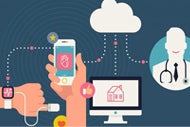

Ochsner Revs Up National Remote Patient Monitoring Plan
 Remote patient monitoring (RPM) got a huge lift during the pandemic as record numbers of Americans opted for connected care from the safety of their homes, but will this trend continue? Ochsner Health is betting it will.
Remote patient monitoring (RPM) got a huge lift during the pandemic as record numbers of Americans opted for connected care from the safety of their homes, but will this trend continue? Ochsner Health is betting it will.
The Louisiana-based health system is marketing its RPM services nationally to health plans and businesses, charging a monthly member subscription fee, according to a recent mHealth Intelligence report. Ochsner, which began offering RPM services to the communities it serves in 2015, has scaled the platform and now monitors more than 20,000 people in health plans across the country.
Ochsner’s strategy is to use the platform to supplement the work of primary care physicians and specialists, collecting data through connected health devices, with data automatically fed into the Epic electronic health records platform. Health and wellness coaching services are added to personalize each patient’s care journey. Providers — often pharmacists — help with medication management to provide an added layer of patient support.
The move is significant because RPM is a key component of high-value care delivery that meets people where they are, which is increasingly beyond the walls of hospitals or doctors’ offices. It will also help Ochsner diversify its revenue streams.
Julie Henry, Ochsner’s chief operating officer for the system’s digital medicine department, says the program includes management, clinicians, tech support staff, coders and programmers, billing and legal experts who work together to ensure that each program targets the right patients using the proper parameters.
The platform, which generated triple-digit growth even before the pandemic, has delivered positive financial results for diabetes and hypertension management, and Ochsner is creating algorithms that would clarify growth opportunities for other conditions. The health system also has been working to demonstrate the RPM program’s value among those with chronic conditions who struggle to pay for their care.
Last year, Ochsner partnered with Louisiana’s Medicaid program to subsidize an RPM pilot in select communities. The goal is to use the data gleaned from the pilot to show the state that it should be investing in this type of service.



